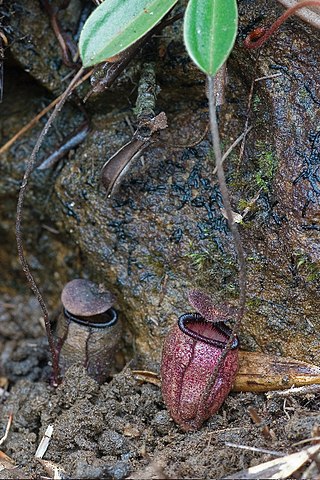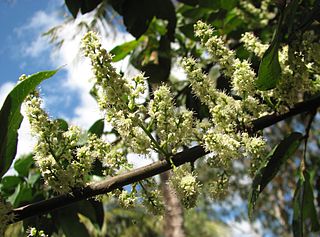
Nepenthes argentii is a highland Nepenthes pitcher plant native to Mount Guiting-Guiting on Sibuyan Island in the Philippines. It is possibly the smallest species in the genus and does not appear to have a climbing stage.

Guioa is a genus of about 78 rainforest tree species known to science, which constitute part of the plant family Sapindaceae. They have a wide distribution, ranging from throughout Malesia, in Burma, Cambodia, Vietnam, Thailand, Malay Peninsula, Borneo, Sumatra, Philippines, Java, Flores, Timor, Sulawesi, Moluccas, New Guinea, further southwards through the east coast of Queensland and New South Wales, Australia and further eastwards to the Pacific Islands, including Tonga, New Caledonia, Fiji and Samoa.

Meryta is a genus in the flowering plant family Araliaceae. There are 28 described species in the genus and a number of undescribed species, all small, resinous trees of the subtropical and tropical Pacific Ocean, characterized by huge, simple leaves and a dioecious sexual system, a unique combination in Araliaceae. Meryta has its center of diversity in New Caledonia. Phylogenetic analyses have placed Meryta as a monophyletic genus in one of the three major clades of the Araliaciae, the Polyscias-Pseudopanax group, and more specifically in the Pacific Schefflera subclade.

A species that is extinct in the wild (EW) is one that has been categorized by the International Union for Conservation of Nature as known only by living members kept in captivity or as a naturalized population outside its historic range due to massive habitat loss.

Cuminia is a genus of flowering plant in the family Lamiaceae, first described in 1835. It contains only one known species, Cuminia eriantha. It is endemic to Robinson Crusoe Island, one of the Juan Fernández Islands in the southeast Pacific, off the coast of Chile and politically a part of that country.

Juania australis, the Chonta palm, is a species of flowering plant in the family Arecaceae, the only species in the genus Juania. It is a solitary trunked palm tree which is endemic to the Juan Fernández Islands archipelago in the southeast Pacific Ocean west of Chile.

Satakentia liukiuensis, is a species of palm tree. They are endemic to Ishigaki Island and Iriomote Island in the Yaeyama Islands, the south-westernmost of the Ryukyu Islands, Japan. It is the only species in the genus Satakentia.

Arctostaphylos catalinae, known by the common name Santa Catalina Island manzanita, is a species of manzanita native to Southern California.
Meryta brachypoda is a species of plant in the family Araliaceae. It is native to the islands of Raivavae and Rapa Iti in the Tubuai Islands of French Polynesia, and to Henderson Island in the Pitcairn Islands.
Meryta drakeana is a species of plant in the family Araliaceae. It is endemic to the island of Tahiti in the Society Islands of French Polynesia.
Meryta lanceolata is a species of plant in the family Araliaceae. It is a tree endemic to the islands of Bora Bora and Tahiti in the Society Islands of French Polynesia.
Meryta lucida is a species of plant in the family Araliaceae. It is endemic to the islands of Raiatea and Huahine in the Society Islands of French Polynesia.
Meryta mauruensis is a species of plant in the family Araliaceae. It is a tree endemic to the island of Tahiti in the Society Islands of French Polynesia.
Meryta raiateensis is a species of plant in the family Araliaceae. It is a tree endemic to the island of Raiatea in the Society Islands of French Polynesia.
Meryta salicifolia is a species of plant in the family Araliaceae. It is a tree endemic to the island of Tahiti in the Society Islands of French Polynesia.
Meryta sonchifolia is a species of plant in the family Araliaceae. It is endemic to New Caledonia.

Oxera is a genus of flowering plants in the family Lamiaceae native to Vanuatu and New Caledonia in the western Pacific.

Pennantia baylisiana, commonly known as Three Kings kaikōmako or kaikōmako manawatāwhi (Māori), is a species of plant in the family Pennantiaceae. It is endemic to Manawatāwhi / Three Kings Islands, around 55 kilometres (34 mi) northwest of Cape Reinga, New Zealand. At the time of its discovery just one plant remained. This single tree grows on a scree slope inaccessible to browsing goats, and has been called "the world's loneliest tree". The species was discovered in 1945 by botanist Geoff Baylis and described in 1948, although it took decades before it was it was fully accepted as a distinct species of Pennantia. Although the only wild tree is female, it was successfully propagated from cuttings in the 1950s, one of which was induced to self-pollinate in 1985. Subsequent seed-grown plants have themselves set seeds, and the species has been replanted on the island, the adjoining mainland, and in public and private gardens around New Zealand.

Meryta latifolia, commonly known as broad-leaved meryta or shade tree, is an evergreen tree endemic to Norfolk Island, Australia, where it occurs in subtropical moist forest conditions.
Pteralyxia laurifolia, the ridged pteralyxia, is a species of plant in the family Apocynaceae. It is endemic to the Island of Oahu in the Hawaiian Islands. The species is listed as vulnerable, threatened by habitat loss.











